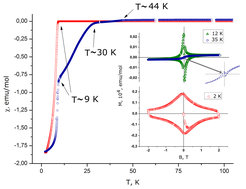Press Release: LixFe1+δSe (x ≤ 0.07, Tc up to 44 K) - a new superconductor prepared by an electrochemical route
Iron-based superconducors were discovered a few years ago as the compound family with the second highest transition temperature besides the cuprate high temperature superconductors. They are promising candidates for technological applications, in particular for high field applications. However many questions regarding the mechanism for the superconductivity in these materials remain unsolved yet.
Tetragonal iron selenide, Fe1+δSe (0.01 ≤ δ ≤ 0.04), is one of the most interesting representatives of these iron-based superconductors. Although its superconducting transition temperature is rather low (Tc = 8.5 K), FeSe offers unique opportunities for structure modification, which significantly enhances Tc up to 40 K. The insertion of large alkaline cations like K or solvated lithium and iron cations in the interlayer space, the [Fe2Se2] interlayer separation increases significantly from 5.5 Å in native FeSe to more than 7 Å in KxFe1+δSe or 9 Å in Li1−xFex(OH)Fe1+δSe, thus largely modifying the original structure and the weakening the interaction between the [Fe2Se2] layers. Therefore, it was common believe that the superconducting transition temperature is strongly depending on the FeSe inter-layer interaction.
In a collaboration between the Max-Planck-MSU Partner Gruppe at the Department of Chemistry of the Lomonosov Moscow State University (MSU) and the Department of Chemical Metal Science at the MPI CPfS, we discovered an electrochemical route to modify the superconducting properties of FeSe. In contrast to conventional chemical techniques, the electrochemical approach allows to insert non-solvated Li+ into the FeSe structure, which preserves the native arrangement of [Fe2Se2] layers and their small separation. Although the amount of intercalated lithium is extremely small (about 0.07 Li+ per f.u.), its incorporation results in the enhancement of Tc up to 44 K (see figure). Quantum-mechanical calculations show that Li occupies the octahedrally coordinated position, while the [Fe2Se2] layers remain basically unmodified. Our results demonstrate that the quasi two-dimensionality of the intercalated iron selenides is much less important for the superconducting Tc than widely speculated before and will stimulate further investigation in this direction. In addition, we have demonstrated that the electrochemical route is a very powerful tool for the synthesis of new materials.
HR / CPfS

Caption: Temperature dependence of the magnetic susceptibility of initial Fe1+δSe crystal aggregates (red squares) and that after treatment at 1.7 V vs. Li/Li+ (blue circles). The insets show the field dependence of magnetization at temperatures below the superconducting transition measured at 12 K and 35 K (top) and 2 K (bottom).
